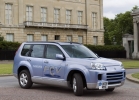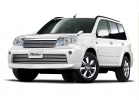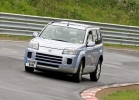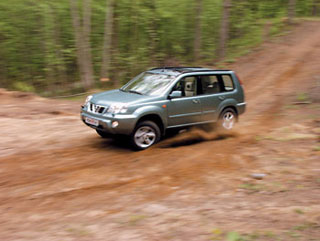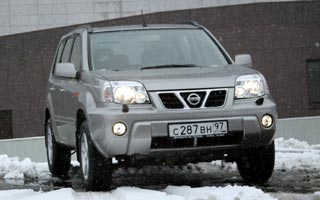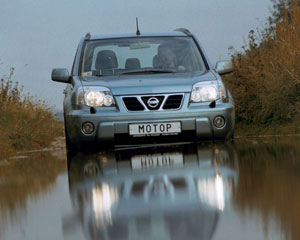Test drive Nissan X-Trail 2001-2003 SUV
Cycles
In the family of hybrids of a jeep and cars solid replenishment. The Nissan X-Trail, Land Rover Freelander and Ford Maverick came to Russia.
This relatively new car breed is becoming more and more popular all over the world. Until now, the choice of cars of this price category in Russia has been small: Honda CR-V and HR-V, Toyota Rav4, as well as the recently joined Hyundai Santa Fe. Three newcomers are able to thoroughly foster the parking lot market.
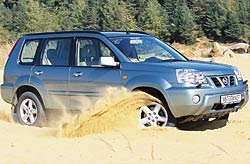
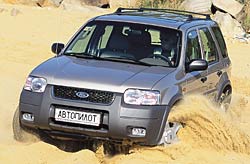
WAY TO TRAVEL. All models are equipped, of course, all -wheel drive. The difference between them is the implementation of the 4x4 mode. Freelander, which is traditionally for Land Rover, has a permanent all -wheel drive with an interaxic WISKOFTA and a constant proportional distribution of torque between the axes. Moreover, in the transmission there is an intermediate reducing gearbox with a constant gear ratio of 1.359. And no differential locks. Although to some extent their role can be played by the anti-operating system.
In Maverick, the main mode of operation of the drive is the front, with automatic, in the case of obvious slipping of the drive wheels, connecting the rear axle. This is in charge of a special multi -disc clutch RBC (Rotary Blade Couppling), which simultaneously plays the role of an intensification differential. For passing heavy sections or off -road, 4x4 Lock mode is provided. In this case, the center differential is blocked, and the torque is distributed between the axes equally. There are no intervaling inter -normal differentials.
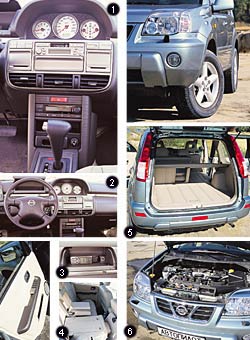 1.2.3. Original, but convenient instrument shield. Under it - containers for drinks. The position of the automatic transmission lever is shown by LEDs between fuel and temperature indicators. On the covered skin of the steering wheel, there is a control of an audio center. In the glove compartment in front of the driver there is a nest of power, for example, for a mobile phone with GPS.
1.2.3. Original, but convenient instrument shield. Under it - containers for drinks. The position of the automatic transmission lever is shown by LEDs between fuel and temperature indicators. On the covered skin of the steering wheel, there is a control of an audio center. In the glove compartment in front of the driver there is a nest of power, for example, for a mobile phone with GPS. 4.5. Folding leather rear seats (they are also adjusted along the angle of inclination) form an even floor with a practical plastic coating. Behind the folding armrest hides an additional window in the trunk.
6. The low -located Nissan motor contributes to the stability of the machine. And the air intake is high, under the very edge of the hood, which reduces the risk of drainage of water.
7. Luxurious cast discs shod in the scandalously known rubber Firestone Wilderness.
8.9.10. The traditional torpedo with rude, but convenient controls for Americans: on the right under the wheel is the automatic transmission poker, whose operating modes are displayed on a small display under the speedometer. Cruise control buttons are located on a leather steering wheel.
11,12. The rear seats with leather upholstery are also folding. But the armrest and the third headrest are absent. The glass of the rear door opens separately.
13. The most powerful Maverick motor is designed for 92nd gasoline. However, it is completely deprived of protection from below.
The farther in the development of all -wheel drive was Nissan. Its transmission works in three modes: only front -wheel drive, the automatic connection of the rear axle and the all -wheel drive mode with the locking of the center differential and the constant distribution of the moment between the axes in the ratio of 57:43. The rear center differential is self -locking, and the disconnected system of dynamic stabilization is also standardized.
Types of equipment. From the point of view of powerful characteristics, Maverick leads with its 197-horsepower engine. Then it follows Freelander with its 177 forces, and the last one is Nissan with a 140-horsepower engine. That is, Nissan seems to be the weakest. This is very relative. In any case, the figures of the specific mass do not differ so much. In Nissan, this indicator is 8.9 kg/hp, and in Maverick - 7.7 kg/hp. And Frelander is almost no different from Nissan - 8.7 kg/hp. Let us, however, note that the X-Trail, produced for Japan, already has a 280-horsepower engine with turbocharges. And the day when he appears in Russia. Then the Japanese will definitely replay all his class enemies.
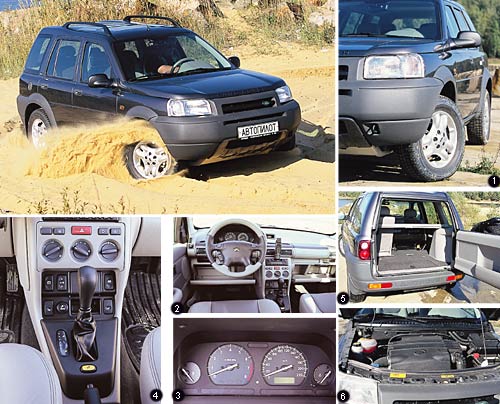 1. Fighting headlights are not included in standard equipment, but Freelander regular light is the best.
1. Fighting headlights are not included in standard equipment, but Freelander regular light is the best. 2.3.4. Symmetric torpedo is equipped with two glove compartment and many shelves for trifles. The operating modes of automatic transmission are displayed on the display under the speedometer. The central console contains all the control keys for additional equipment. The yellow button in front of the checkpoint selector turns on the HDC system. It works only in first gear and reverse.
5. The luggage compartment looks modest, but the seats fold, like large SUVs: the back is laid on the pillow, then everything rises vertically. The glass of the rear door is lowered, with remote control.
6. The motor compartment, compared with the predecessor, has become a little longer to fit a V-shaped six. Below the engine is protected by a powerful duralumin plate.
But this will happen later, but for now, in terms of the dynamics, Maverick breaks forward. And in the literal and figurative sense. Although, it would seem, the Freelander machine type STEPTRONIC, coupled with a 6-cylinder engine, should provide the Englishman with advantages. But the permanent decrease mode in the handout of the Land Rover transmission is to blame. He provides him with the advantage of off -road, but dulls the dynamics on the asphalt. But in a fully automatic mode, Freelander behaves like a well -iculated butler: before executing the order, he will definitely inquire whether Sir is sure that he wants this. However, in the manual mode of gear shifts, his reactions become much more active, but, you see, constantly pull the lever back and forth, which is also very low-an occupation is undoubtedly for an amateur.
All three cars have an independent suspension, and the rear of Maverick also has a steering effect. However, the settings of the pendants themselves are significantly different. And cars behave on the road differently. Especially in the speed of turns and during maneuvers. From this point of view, Nissan entered the leader. He rides very confidently, understandably and predictably, allows you to pass turns at higher speed without tension than competitors. The second place is occupied by Maverick, and Freelander is in the tail. Not that he has these maneuvers worse. Very comfortable, but softer, compared to the Japanese and even an American, the suspension causes excessive body rolls. And this is unpleasant - strains and makes you reduce speed.
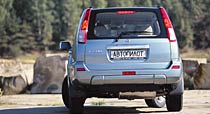
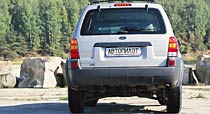
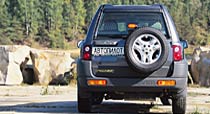
Form of expression. It is clear that none of these cars is designed to overcome serious off -road. The task is simple - to drive where it is better on an ordinary car and not to meddle. The whole trinity copes well with this. The energy intensity of the suspension is enough to grab on an uneven gravel country at a speed of about 80 km/h. Short front and rear overhangs allow all three painlessly to cross through ditches and cuvettes. Climbing a tall and steep slope and going down from it is also not a problem.
However, in general, in a situation outside the asphalt, the alignment of forces is somewhat changes. In favor of Freelander and X-Trail. In dry sand, for example, where the Englishman and the Japanese make his way without much tension, Maverick begins to actively slip, rising clouds of dust. Only the supply of power and moment saves. The advantages of Freelander on the roads are undoubtedly more include, as much as 2 cm, clearance and the presence of powerful standard protection from aluminum alloy. In addition, all versions with a 6-cylinder engine are equipped with an HDC system (forced speed restriction within 10 km/h when descent from slippery slopes). Moreover, this system works both in the movement forward and reverse. And X-Trail, thanks to a very low center of gravity, exceeds all three in transverse stability. Freelander unexpectedly discovered an unpleasant drawback-all the water from the puddle on the road for some reason flies straight to the windshield.
Portrait of the owner. Without going into reasoning in terms of aesthetics and style, for the final sentence depends on the personal addictions and tastes of people, we note only some characteristic practical features. After all, they also affect the choice. The best optics is Freelander. At night, the road and roadsides are excellently illuminated, the light of the train spotlight recalls. The cleanest body and thresholds (they are closed by the lower edge of the doors) and, as a result, in any weather, clean trousers at the driver and riders at X-Trail. The dropping glass of the rear door at Frelander and the separately opening glass of Maverick are very practical. The most convenient entrance and output is to Maverick. It also contains the most convenient provisions of the driver's seat. Actually, the seats are most ergonomic in X-Trail. In it, the most unusual and most stylish (and at the same time convenient) dashboard, although located exactly in the middle of the torpedo. In the Japanese and the most practical luggage department. Then there is Frelander, and Maverick is in the last place.
In terms of the level of interior decoration, the number of all kinds of useful shelves and messages X-Trail and Frelander are approximately at the same level. Maverick is widest, American is rustic. In terms of equipment, the X-Trail wins the options and the variety of configuration options.
Each of the cars, as we have seen in a few days of the test, has its own pronounced character. You can’t glue the female or male label to them. Maverick is a rude American with a cowboy manner and a habit of putting a leg on the table. Freelander is a fit English gentleman equipped for light safari, X-Trail is a polite, but full of self-esteem and internal strength of traditions, a descendant of samurai. And you can say for sure: the one who drives today, about which we wrote about at the beginning of the test, will seriously think about-what to buy in a year or two?
Text Andrey Timofeev, photo Alexey Ilyin
Model/Modification Nissan X-Trail Ford Maverick Land Rover Freelander
Producer Japan of USA England
Body wagon wagon wagon
Number of doors/places 5/5 5/5 5/5
ENGINE
Basin type with multi -point electronic injection
The location of the front transversely transversely in front transversely
Working volume (cubic meter cm) 1998 2967 2497
Number/location of cylinders 4/rowing 6/V-shaped 6/V-shaped
Cylinder diameter x Piston stroke (mm) 89.0x80.3 89x79.5 80x82.8
Power, kW (L.S.) at about./Min. 103 (140) at 6000 145 (197) at 6000 130 (177) at 6250
Max. Torque (Nm at about./min.) 192 at 4000 265 at 4750 240 at 4000
TRANSMISSION
Drive connected full connected full permanent full
Gearbox Automatic 4-speed automatic 4-speed automatic sectral 5-speed
SUSPENSION
Front independent, on a subframe, spring -loaded racks on the upper and lower levers, an independent, spring -loaded racks on the transverse levers, an independent, spring -loaded stabilizer on the transverse levers, and the reptile stabilizer.
The rear independent spring multi -link, with longitudinal, transverse and diagonal levers, the transverse stability stabilizer Independent spring multi -core on the subframe, the transverse stability stabilizer Independent, spring -loaded racks on trapezoidal levers, repetitive stabilizer
STEERING
Type gear rack with an integrated-type hydraulic power steering gear with an integral-type hydraulic mission with an integral-type hydraulic mission
Min. The diameter of the turn (m) 11 11.2 11.6
Brakes
Front / rear circular ventilated / disk continuous ventilated disk / drum circular ventilated / drummer
ABS Electronic 4-channel electronic 4-channel electronic 4-channel
Wheels
Tire size 215/65 R16 235/70 R16 215/65 R16
Dimensions/volumes/weight
Length/width/height (mm) 4510/1765/1675 4395/1780/1700 4445/1805/1710
Wheel base (mm) 2625 2620 2560
The track front/back (mm) 1530/1530 1555/1550 1535/1545
Clearance (mm) 200 200 220
The volume of the fuel tank (L) 60 62 59
Equipped mass (kg) 1452 1570 1525
Dynamic characteristics
Maximum speed (km/h) 180 190 182
Acceleration to 100 km/h (sec.) 13.1 10.2 10.1
Economy
Fuel consumption (l/100 km) city/mixed cycle/highway 12/7.7 18.9/9.3 17.2/9.7
The price in Moscow is about $ 35 thousand $ 36.3 thousand $ 42 thousand.
A source: "Autopilot"
Video Crash tests Nissan X-Trail 2001-2003
Test drives Nissan X-Trail 2001-2003
Krash Test Nissan X-Trail 2001-2003
Krassh Test: Detailed Information26%
Driver and passengers
10%
Pedestrians

